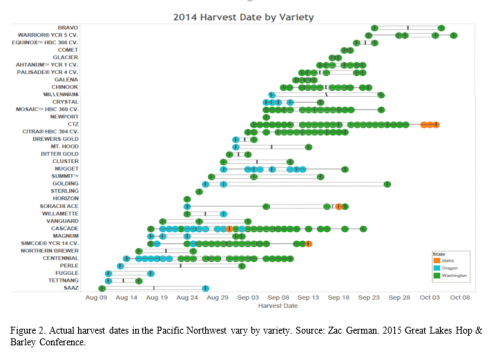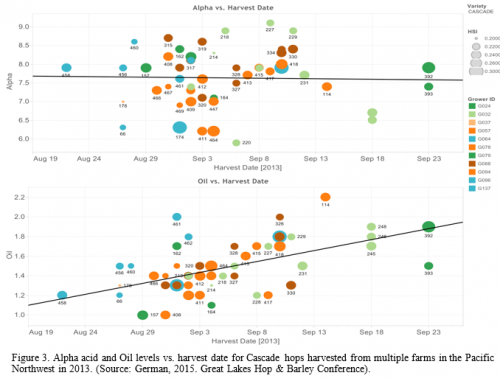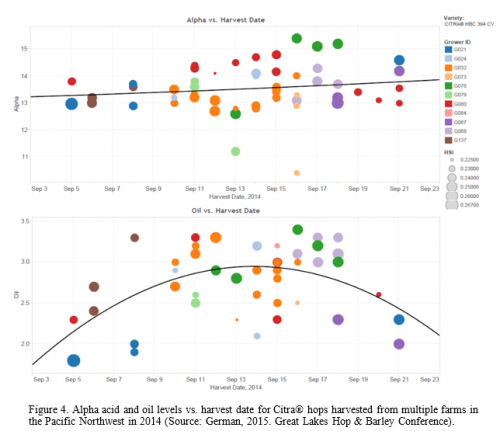Hop harvest 2016
Lab analysis of hop samples is the best way to determine optimum harvest date.

The harvest period for hops in Michigan generally occurs from the middle-end of August through the end of September. Hop harvest dates can vary depending upon location, conditions over the growing season and, most importantly, by cultivar. In general hops are not harvested at physiological maturity but rather at a point when they reach the highest “brewing value.” Hops harvested too early can result in low alpha acid content, low oil content and reduced plant vigor the following year. Hops harvested too late can result in poor aroma, oxidation and poor external quality. Researchers in Germany conducted field experiments to determine the harvest window for multiple cultivars based upon alpha acid content, aroma, yield, external quality and plant vigor. They found that the optimal harvest time and overall harvest window can vary substantially based upon cultivar (Figure 1). At the 2015 Great Lakes Hop & Barley Conference, Zac German presented a chart that showed a similar broad range of hop harvest date depending upon cultivar and location (Figure 2). With such a broad range in hop harvest dates, how should producers determine the optimum harvest dates?
When attempting to determine optimum harvest date, growers should consider cone dry matter, hop quality measures (essential oils, alpha acids, H.S.I., etc.), pest and disease pressure, and weather conditions. The best way to obtain this information is to submit weekly hop samples for each cultivar or lot to a testing lab for analysis. You can find a list of laboratories here. Results and recommendations will allow growers to refine the timing of their harvest. In the major hop growing regions, harvest is generally targeted when cones reach an average of 22-23 percent dry matter. Growers can expect dry matter content to increase by 1 percent every 4-7 days depending on variety and environment. For smaller scale hop producers or home gardeners the University of Vermont Extension provides a “Hop Harvest Moisture Calculator” that can help determine hop dry matter percentage. Commercial scale should seriously consider purchasing a table top moisture meter to determine harvest moisture and post-drying moisture levels.
Recent research demonstrated that essential oil and linalool content in Saaz hops continued to increase through mid-September as did hop aroma and intensity (Matsui et al. 2016). While many growers may be harvesting too early to maximize aroma, as mentioned, other factors like alpha acids, appearance, pest/disease issues, annual and geographic variation, and a limited harvest window may override maximization of aroma. Moreover, essential oils may not continue to increase with all cultivars and all regions. For example, as shown below, German (2015) found that alpha acid levels in both cascade and CitraÒ hops remained relatively stable across the range of harvest dates (Figure 3 & Figure 4). However, there were stark differences in oil content between Cascade and CitraÒ hops as the season progressed.
To conclude, hops harvested at different dates produce beer with significant, distinguishable differences in sensory analysis testing, indicating the importance of harvest date on beer quality. The best bet for growers in new regions may be to strive for a balance between optimization of hop quality and the day to day practicalities of harvesting hops in a timely and efficient manner.
Please continue to visit Michigan State University Extension’s hop webpage or the MSU Hops News Facebook site for up to date information.



 Print
Print Email
Email







